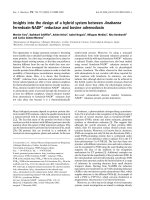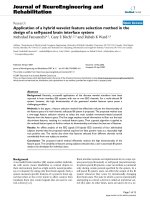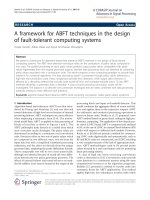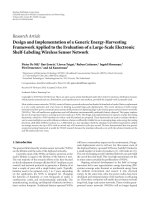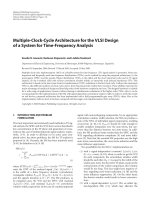THE DESIGN OF A PASCAL COMPILER
Bạn đang xem bản rút gọn của tài liệu. Xem và tải ngay bản đầy đủ của tài liệu tại đây (239.12 KB, 39 trang )
<span class="text_page_counter">Trang 1</span><div class="page_container" data-page="1">
The Design of A Pascal Compiler
Mohamed Sharaf, Devaun McFarland, Aspen Olmsted
</div><span class="text_page_counter">Trang 2</span><div class="page_container" data-page="2">Part I
Mohamed Sharaf
</div><span class="text_page_counter">Trang 3</span><div class="page_container" data-page="3"><small>The compiler is written in its own language.</small>
<small>The compiler is intended for the CDC 6000 computer family.</small>
<small>CDC 6000 is a family of mainframe computer </small>
<small>manufactured by Control Data Corporation in the 1960s.It consisted of CDC 6400, CDC 6500, CDC 6600 and </small>
<small>CDC 6700 computers, which all were extremely rapid and efficient for their time.</small>
<small>It had a distributed architecture and was a reduced </small>
<small>instruction set (RISC) machine many years before such a term was invented.</small>
</div><span class="text_page_counter">Trang 4</span><div class="page_container" data-page="4">Pascal Language
Imperative Computer Programming
Language, developed in 1971 by Niklaus Wirth.
The primary unit in Pascal is the procedure.
Each procedure is represented by a data segment and the program/code segment. The two segments are disjoint.
</div><span class="text_page_counter">Trang 5</span><div class="page_container" data-page="5">Compiling Programs: Basic View
<small>Pascal compiler</small>
<small>Machine language </small>
<i><small>filename .</small></i>
<small>pPascal program</small>
</div><span class="text_page_counter">Trang 6</span><div class="page_container" data-page="6"><small>Array types </small>
<small>the first term is computed by the compilerw=a+(i-l)*s</small>
<small>Record types: reside only within one PSU if it is </small>
<small>represented as packed. If it is not packed its size will be the size of the largest possible variant.</small>
</div><span class="text_page_counter">Trang 7</span><div class="page_container" data-page="7"><small>s’ ”File component size”s=n*s’</small>
<small>The buffer should be able to hold at least one Physical Record Unit (PRU). “PRU : the unit that is used to represent file on secondary storage”</small>
<small>Class types</small>
<small>Domain: the component of the class variable to which they are bound.The allocated area of memory is calculated by the compiler.</small>
</div><span class="text_page_counter">Trang 10</span><div class="page_container" data-page="10"><small>* Tax-It v1.0: This program will * electronically calculate your tax * return.</small>
<small>* This program will only allow you to * complete a Canadian tax return</small>
<small>program taxIt (input, output);</small>
Example Header
</div><span class="text_page_counter">Trang 11</span><div class="page_container" data-page="11">List of constantsList of variables
</div><span class="text_page_counter">Trang 12</span><div class="page_container" data-page="12">Reserved Words
gotoif
</div><span class="text_page_counter">Trang 13</span><div class="page_container" data-page="13">Reserved Words
typeuntilvarwhile<small>For more information on reserved words go to the url: a predefined meaning in Pascal that cannot be changed</small>
label
</div><span class="text_page_counter">Trang 14</span><div class="page_container" data-page="14">Standard Identifiers
Have a predefined meaning in Pascal
<i><b>that SHOULD NOT </b></i>
be changed
Predefined types
Predefined files
<small>For more information on standard identifiers go to the url: class="text_page_counter">Trang 15</span><div class="page_container" data-page="15">
Predefined Functions
<i><b><small>Know the ones in Table 3.1 of your book.</small></b></i>
</div><span class="text_page_counter">Trang 16</span><div class="page_container" data-page="16">Predefined Procedures
writeln
</div><span class="text_page_counter">Trang 18</span><div class="page_container" data-page="18">To represent procedure uniquely:
<small>The address of the entry point of the code.The address of the data segment of that procedure declared local variables.</small>
</div><span class="text_page_counter">Trang 20</span><div class="page_container" data-page="20">Syntax Analysis
Conway “Separable transition diagram”:
<small>The syntax of the language is presented as a </small>
<i><small>finite set of pseudo-finite-state recognizers. This </small></i>
<small>is because the basic symbols to be recognized are replaced by sentences are replaced by the member of this set. Using TD Parsing.</small>
<small>The syntax of the language is formulated as a set S of finite graphs.</small>
<small>It is straightforward to translate to and from the diagrams to BNF and it is easy to verify </small>
<small>To strictly adhere to the constraint of a symbol lookahead .</small>
</div><span class="text_page_counter">Trang 21</span><div class="page_container" data-page="21">one-Part II
Devaun McFarland
</div><span class="text_page_counter">Trang 22</span><div class="page_container" data-page="22">Performance and statistical data
At a Glance
The Source Program
<small>Distinct identifiersWord-delimiters</small>
<small>End, begin, if, then, and else</small>
</div><span class="text_page_counter">Trang 23</span><div class="page_container" data-page="23">The object program:
Field length requires 19,000 words
Compiler Program proper – 67.8%Object code Buffering – 4.7%
Object Table – 9.2%Other Data – 4.5%
Input and Output Buffering – 8.3%Interface and I/O routines - 5.5%
</div><span class="text_page_counter">Trang 24</span><div class="page_container" data-page="24">Program Instruction Set
Program consists of 32,700 instructions as follows:
Long instructions(30-bit) = 48.7%Short instructions(15-bit)=28.7%
Padding Instructions(NOOP)=22.8%Long/Short instruction breakdown
<small>Fetch/store, load literal, arithmetic, logical/shift, base address register, and jumps/subroutine calls. </small>
</div><span class="text_page_counter">Trang 27</span><div class="page_container" data-page="27">Compiler Design Technique
1968 – Earlier version of PASCAL
Compiler written in FORTRAN - the motive here is a result of wanting a compiler that could be available automatically for multiple computers.
</div><span class="text_page_counter">Trang 28</span><div class="page_container" data-page="28">Task division
Type definitions, variable declarations and procedure headings including formal
parameter list.
Expressions and Statements.
Interface with the operating system.
</div><span class="text_page_counter">Trang 29</span><div class="page_container" data-page="29">Part III
Aspen Olmsted
</div><span class="text_page_counter">Trang 30</span><div class="page_container" data-page="30">Relationship Between The
Complexity of Compilation and Computer Architecture
</div><span class="text_page_counter">Trang 31</span><div class="page_container" data-page="31">Desirable Computer Architecture Properties
<small>Pascal is a language designed without any specific computer in mind </small>
<small>At Least Two Registers</small>
<small>Simplicity of Instruction Set</small>
<small>Make optimizations unnecessary </small>
</div><span class="text_page_counter">Trang 33</span><div class="page_container" data-page="33">Graph of Instructions By %Source Code
</div><span class="text_page_counter">Trang 34</span><div class="page_container" data-page="34">Conclusions
</div><span class="text_page_counter">Trang 35</span><div class="page_container" data-page="35">Program Comparison
<small>Compared Algol, Fortran & Pascal on 4 programs:Matrix multiplcation B: A*A, no output</small>
<small>Sorting an array of 2,000 numbers</small>
<small>Finding all possible additive partitions of integers 1-30Counting the characters in a file</small>
<small>The performance differences between languages was negligible</small>
<small>The reliability of the code generated by Pascal was higher</small>
</div><span class="text_page_counter">Trang 37</span><div class="page_container" data-page="37">Syntax Diagram - Simple Expression
<small><Simple Expression> :== <Term> | <Simple Expression> <adding operator><Term> | <adding operator><Term></small>
</div><span class="text_page_counter">Trang 38</span><div class="page_container" data-page="38">Syntax Diagram - Term
<small><Term> :== <Factor> | <Term> <multiplying operator><Factor></small>
</div><span class="text_page_counter">Trang 39</span><div class="page_container" data-page="39">Syntax Diagram - Factor
<small><Factor> :== <variable> | <unsigned constant> | <function designator> | <set> | (<expression>) | !<factor></small>
</div>



